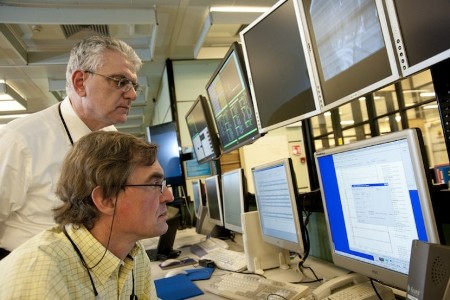Joint European Torus (JET), the largest magnetic fusion device in the world, is now ready to commence new experiments after several enhancements. The interior part of the machine has an entirely new wall.
The enhancements include usage of new materials in the JET vessel, additional diagnostic systems and increase in heating power. JET is the first fusion machine designed for testing the materials that will be utilized inside ITER, the new generation international experiment.
 EFDA Leader Francesco Romanelli (back) and physicist Emmanuel Joffrin (front) following an experiment at JET.
EFDA Leader Francesco Romanelli (back) and physicist Emmanuel Joffrin (front) following an experiment at JET.
The first experimental initiative has been commenced by the European researchers at JET followed by successful implementation of the ‘ITER-Like Wall’. The research is carried out under the European Fusion Development Agreement (EFDA) and scientist investigate the ability of fusion power for application as a clean, safe and virtually limitless energy source for new generations.
Beryllium and tungsten tiles are currently used in the interior part of the JET vessel, resulting in ‘ITER-Like Wall’. Beryllium compound is employed in the main wall and tungsten is used for the exhaust component that needs to resist high heat flux. The future studies will focus on assessing the behavior of the wall materials that are selected to build ITER.
Another improvement in the JET project is a boost in the heating power by 50%. The additional power will support JET to reach higher plasma temperatures and ITER conditions. EFDA associate laboratories have developed new diagnostics systems, which allow deep examination of the scientific challenges associated with ITER conditions.
JET machine will be gradually upgraded to full power for enabling accurate analysis of the ITER materials. In order to allow full utilization of JET vessel’s new capabilities, researchers have planned to use deuterium-tritium fuel mixture of ITER by 2015.